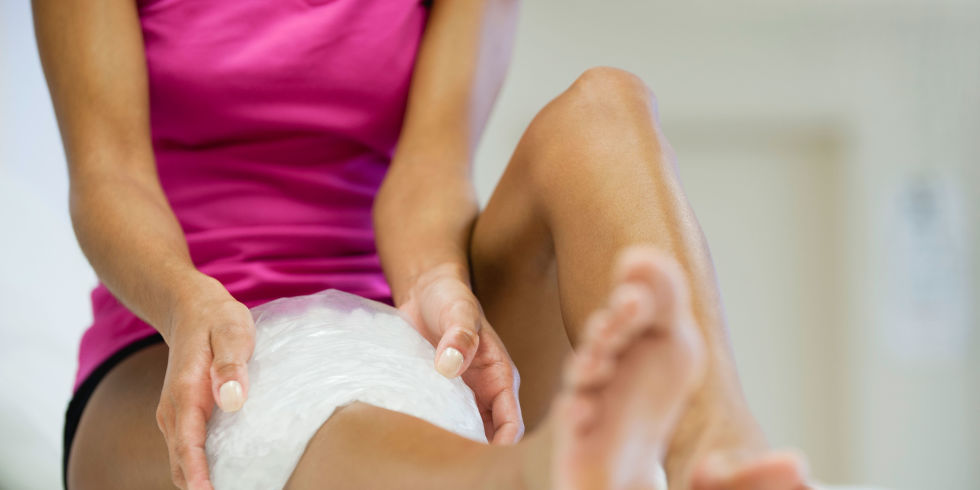The knee joint is a very complex joint made of bones, muscles, tendons, and ligaments, which need to work together and in coordination in order to move the lower part of the body while working out. Regular physical exercise is very important for your own health. If you exercise regularly but still have sore knees after workout, then you should take some preventive measures to keep your muscle soreness from developing into a more serious condition. Read on and learn when it is time for you to worry about and when to seek professional medical help.

What Causes Sore Knees After Exercise?
There are a number of causes that can lead to sore knees after a workout. Muscle soreness is the most common cause. It is less severe compared to other causes of knee soreness after a workout. Muscle soreness usually occurs after lifting weights that are focused on the legs, particularly on the calf muscles and hamstring muscles. Runners and cyclists usually develop a knee soreness on the sides.
Joint degeneration is another cause of sore knees after workout. Normally, this is a severe problem caused by a chronic and often not curable condition such as osteoarthritis.
During the workout you can end up with a knee injury. Conditions like the iliotibial band syndrome or the Runner’s knee lead to knee pain. Knee injuries or an overuse due to excessive physical activity can cause knee pain. If you still have knee pain even after taking some rest and not working out for a couple of days, then you should seek professional medical help and get your knee evaluated for any possible injury.
How to Deal with the Knee Soreness
If you experience sore knees after workout there are a couple of things you should know regarding treatment in order to reduce the inflammation, the swelling, and the knee pain. In order to reduce the swelling, you should apply ice on your affected knee for 15 minutes. NSAIDs can help when it comes to the treatment of knee pain. Compressive bandaging, as well as, elevating the knee can help recover faster.
Physical Therapy Exercises
If you have knee soreness after working out, then you should probably focus more on muscle strengthening exercises. If your muscles are stronger than normally, your knee will be more stable and less prone to injuries. Exercises recommended for strengthening the muscles of the legs are calf raises, squares, lunges, etc.
Warning
If you still feel pain even after resting and taking all the conservative measures, then it’s time for you to seek professional medical help. If you can’t put weight on your knee, if your knee becomes more and more swollen, and if you experience a clicking noise or buckling of the knee, then you should seek immediate medical help as these are signs of something more serious which requires proper evaluation and medical treatment.
How to Prevent Sore Knees After Workout
Don’t Forget Leg Stretches
Leg stretches are very important so don’t forget to do them once you have finished with leg strengthening exercises. This way you will make sure that your muscles don’t get tightened, contributing to knee pain. There are various leg stretches you can do such as:
- Hamstring stretch – Place your leg on a step or on a curb of the sidewalk. Stretch the opposite arm toward the knee or the ankle. Hold in that position for a couple of seconds and switch legs.
- Butterfly stretch – Sit on a mat and keep your feet pressed together so that your legs form a shape of a diamond. Hold the feet in that position with your hands and take a deep breath. Remain in that position for a couple of seconds. Slowly lean up your body forward and exhale. Don’t bend your lower back but keep it straight.
- Hip flexor stretch – Lie on the floor on your back while keeping the arms on the sides of your body. Bend your knees, but keep your feet on the floor. Your heels should be close to your fingers, almost touching them. Press the heels down and lift your hips as much as you can. Remain in that position for a couple of seconds. Repeat this hip flexor stretch couple of times.
- IT band stretch – Stand up and cross your legs. Lean your body on the side. Hold in that position for a couple of seconds. Switch the legs and lean on the other side.
Don’t Lock Out the Knees
When working out, make sure not to lock the knee, nor not to completely straighten it as this can lead to a knee injury. Keep the knees in a slightly bent position when exercising.
Don’t Move Your Knee Past Your Ankle
When performing certain types of exercises such as squats, lunges or other leg exercises, don’t move your knee past your ankle to prevent any knee injury. Keep your knee at a 90 degree angle always.
Wear Comfortable and Supportive Shoes During Workout
If you exercise in uncomfortable shoes, then there is a great possibility you will end up with an ankle or knee injury. When buying training shoes, make sure to buy supportive shoes, which will support your knee and prevent a knee injury.
Stop Exercising If Your Knee Hurts
If your knee hurts and if you experience a shooting pain in your knee, then this is a sign that you should stop working out. It could also indicate that you are not doing the exercises correctly. Check if you are not locking your knee if your knee is not passing past the ankle, if you are wearing comfortable and supportive shoes. If the knee pain persists even after taking a couple of days rest, seek professional medical help.
